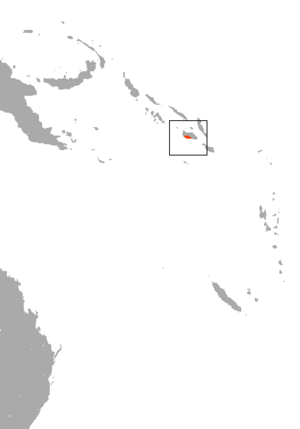Montane monkey-faced bat facts for kids
Quick facts for kids Montane monkey-faced bat |
|
|---|---|
| Conservation status | |
| Scientific classification | |
| Genus: |
Pteralopex
|
| Species: |
pulchra
|
 |
|
| Montane monkey-faced bat range | |
The montane monkey-faced bat, also called the montane flying monkey, is a special kind of megabat. Megabats are usually large bats that eat fruit and nectar. This bat is found only in the Solomon Islands, which means it is endemic there.
Scientists believe this bat is in great danger. It is listed as a critically endangered species. This means it could disappear forever very soon. The Alliance for Zero Extinction has even named it as a species facing immediate extinction. In 2013, Bat Conservation International put this bat on its list of 35 top priority species for protection around the world. So far, only one of these bats has ever been found by scientists.
Contents
About the Montane Monkey-Faced Bat
How Was It Discovered?
The montane monkey-faced bat was first described as a new species in 1991. An Australian scientist named Tim Flannery discovered it. The first bat found, called the holotype, was collected in May 1990. It was found on Mount Makarakomburu on Guadalcanal Island. The bat's scientific name, pulchra, comes from a Latin word meaning "beautiful."
What Does It Look Like?
This bat is the smallest type in its group, called Pteralopex. The first bat found weighed about 280 grams (0.6 pounds). Its head and body together were about 16.2 centimeters (6.4 inches) long. Its forearm was about 11.8 centimeters (4.6 inches) long. Its ears are short and narrow, about 1.7 centimeters (0.7 inches) long.
Like other monkey-faced bats, its wings attach to its body close to its spine, not at its sides. It also has a strong ridge on its head called a sagittal crest. This bat has very large canine teeth. One of its most amazing features is its "striking" red eyes! Its flight membranes, which are like its wings, are black and white.
The bat's head, face, and back are blackish. The fur on its belly is yellowish. Its ears are black, but the fur at the bottom of each ear is white. Scientist Tim Flannery said it was the "most attractive" bat in its group because of its beautiful colors.
Where Does This Bat Live?
Its Home and Habitat
Scientists believe the montane monkey-faced bat lives in montane forests. These are forests found high up in mountains, usually above 1,200 meters (about 3,900 feet) above sea level. So far, this bat has only been seen in the high-up forests of Guadalcanal island in the Solomon Islands.
Protecting the Montane Monkey-Faced Bat
Why Is It Critically Endangered?
The IUCN (International Union for Conservation of Nature) says this bat is critically endangered. This means it might even be extinct already. If it's not extinct, the IUCN thinks there might be fewer than 50 adult bats left. These few bats would all live in one small area.
In 2015, scientists searched a lot but could not find any more of these bats. This means the bat found in 1990 is still the only one ever seen. In 2010, a group called WildEarth Guardians asked the United States government to protect this bat. They wanted it listed under the Endangered Species Act. This request is still being reviewed.
Can We Find More Bats?
Scientist Diana Fisher studied how likely it is to find mammal species that haven't been seen in many years. The montane monkey-faced bat was one of the species she looked at. She said that some mammals thought to be extinct might still be found, and she specifically mentioned this bat.
Fisher and another scientist, Blomberg, found that how long a mammal has been missing is important. Species that haven't been missing for a very long time are more likely to be found again. Also, mammals with larger living areas are more likely to be rediscovered. If a mammal disappeared because its home was destroyed, it's more likely to be found than if it disappeared due to overhunting.
In 2015, Bat Conservation International gave money to Australian researchers. They hoped these researchers could find where any remaining populations of the bat might live. However, the bat found in 1990 is still the only known example of this species.
Images for kids



